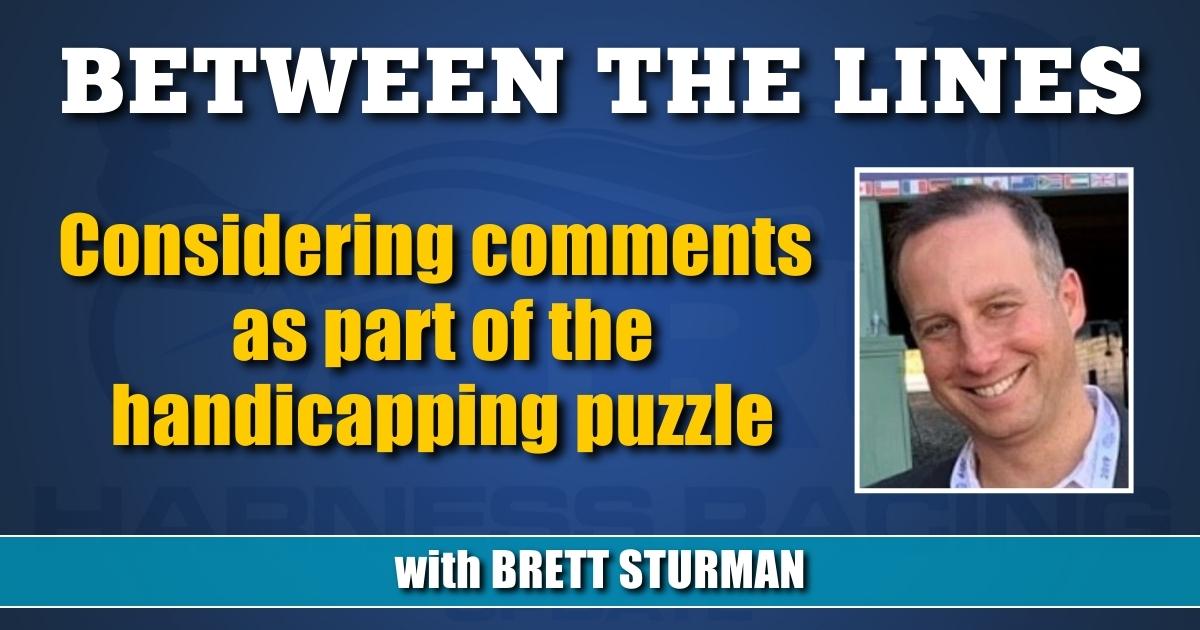

Considering comments as part of the handicapping puzzle
by Brett Sturman
Popularized in 2022 in its partnership with The Meadowlands to provide driver and trainer commentary in advance of races, the website Inside Harness has become a go-to for many handicappers looking for firsthand insights from race participants into the weekend races. The site also offers commentary for other harness tracks as well, though it’s participants from The Meadowlands that provide far and away the greatest amount of content.
From my perspective, the effectiveness of the comments comes down to how handicappers choose to incorporate them into all other more traditional handicapping factors. Like anything else with handicapping, there isn’t a single be-all end-all trick to being able to pick winners. More information is better and there’s absolutely a place for the commentary that Inside Harness aggregates from drivers and trainers that can complement the handicapping process. I think of it similar to how professional athletes are asked at press conferences how they may be preparing for an upcoming game and how bettors can incorporate that information.
The most useful comments are those that give the handicapper information that they wouldn’t have known otherwise. For example, comments of lesser value are anything that I could tell for myself by looking at a program or watching a race replay. I know for myself if a horse is stepping up, has drawn bad, or has been racing sharp or poor lately. And frankly, in those matters, I’d trust what I can see with my own eyes more than someone else’s opinion. On the other hand, comments that indicate how a horse had trained in the week leading up to the race, or if a horse was later found to be sick after a poor prior performance, those are the types of insights that can be extra beneficial.
Sometimes, the way you see a race shape up, or even how a driver or trainer sees the race shape up, may be different than how that race unfolds. In races where best laid plans and initial strategy are often changed on the fly once it begins, it should be understood that the race direction implied by comments aren’t set in stone. A fascinating example of the relationship of how comments fit into the context of the race came from The Meadowlands on April 1.
In a N/W 2 race, Ants Marching was one of three Nancy Takter trainees in the race. A 1:52.2 winning 2-year-old from last year, he had closed out that season with respectable tries in the Kindergarten Final and in a Governor’s Cup elimination. He qualified back nicely to be second in a qualifier won by a talented older horse, Red Right Hand. Last Saturday marked his first start back on the year; always a tricky proposition to determine how a horse will be raced in that situation.
On Inside Harness, Takter’s comment was: “Nice colt unfortunate he drew bad as he will not be blasted off the gate. Have to hope for a flow to develop.”
The way that the race played out was anything but. Ants Marching was driven by Takter assistant trainer Josert Fonseca, who had also driven Ants Marching throughout last year. Ants Marching was pushed from the gate, pressed onward for the lead as there was no hole available into the first turn and eventually cleared to the lead right by the quarter mile mark. He won by a comfortable-enough one and a quarter length margin as part of his wire-to-wire win.
In response to Twitter chatter on the race, Takter replied: “That was the plan, but he was a little fired up warming up in the rain and I told Josert not to fight him if he wanted to leave.” Takter also added, though more relevant to other Meadowlands policies: “Now mind you had he been allowed to tuck into a hole he would’ve probably been given one as he would’ve been a good horse to follow.”
I have no problem with any of this. Nothing is automatic, especially when it comes to race strategy that could be driven based on how a horse warms up, scores down and feels on the gate, as well as what’s going on with all the other horses in the race. In this case, even though Ants Marching had drawn badly, he really was the class of the field. Despite making his first start since last fall, he was sent off as the co-8-5 favorite, so regardless of race strategy, bettors correctly surmised that this horse would figure into the race.
Perhaps the answer lies in the commentary from everyone being more driven to reporting on the horse, more-so than race strategy. As seen, race strategy is subject to change and it’s not really in the best interest of the connections to divulge race strategy to start with.
To that point, there have been plenty of instances where introspective comments have led to high paying winners.
As examples, this past winter, trainer Joseph King said that his horse Amador had a good week and had been training good. He said this for back-to-back starts and Amador paid $76.60 and $101.40 in those consecutive starts. Last year Travis Alexander wrote a comment on the horse High Baller who won and paid $77.80, where he said: “Not the class I entered by here we are. Hoping for the best.” This comment is helpful because often I wonder what a horse is even doing in a certain class. In this case, the horse could have very well been sharp and was placed there by the race secretary, rather than the trainer electing to place him by himself in a race perceived to be over his head.
The examples could go on. Nicole DiCostanzo left a comment last year on Magnolia Volo that said “Took some getting to know here. Unfortunate break last week, due to an off track. Made some changes.” After providing comments that spoke to a growing familiarity with the horse and further changes made, Magnolia Volo went out and paid $54.70 to win. Just last month trainer Juan Cano said in regard to Sd Watch Me Now “Been a project but if he can stay flat tonight, he has a good chance.” Sd Watch Me Now did stay flat and paid over $33 in doing so.
Like anything else in handicapping, sometimes the angles work and sometimes they don’t. But any additional information to arm the handicapper, especially information that comes firsthand that you’d never have access to otherwise, is certainly a positive. It’s just a matter as to how each handicapper elects to use that information which determines its success.















